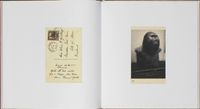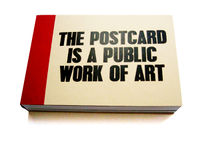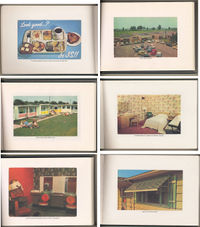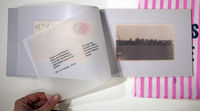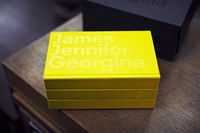Proposal Draft
Physical Photobook - 29 January 2015
After the talk with Kate Pullinger, I figured some out. It’s hard to get all of your elements of your research in one book. Maybe I don’t get even one, because the photobook is just a fixed frame to work with. The elements what I choice to work with, after the exercise with Kate are:
Gift – Invitation
I had many keywords for my research, but gift is the easiest one to work within a photo book. My first thoughts where ‘share’ and ‘collaboration’. But gift goes one way, and share goes both ways. So let’s try to just go one way.
One of my first ideas is to do something with my postcards what I receive over the past years from my mom. I estimate about 60/70 postcards I have, with all different kinds of pictures on them. Since I left my hometown Maastricht I receive postcards but I’m saving them now for 3,4 years. It’s not that often in this time that people receive postcards from their mother or family. But I also send postcards back, and my mom saved them to.
So for the photobook I’m going to scan all the cards from my mother and from myself, and make two books out of them. Those two books speak to each other. A mom and a daughter living apart and sending each other postcards. The postcards are a gift, a gift that I want to share with others. Specialty nowadays, when almost nobody send them anymore. In the back of the book you can send a postcard yourself, to me, or my mother or to someone else. (When you read the book of my mom, I’ll feel sorry and maybe you want to send her a postcard.) Like an invite to send a gift to someone.
I did some research to other photobook with postcards, because they are very common.
Anne Sophie Merryman - “Mrs. Merryman's Collection” 2012
Miki Soejima is a magical realist, an escapologist who, for the first time, is stepping out to claim her identity as the photographer behind Mrs. Merryman's Collection, winner of the 2012 First Book Award. In the school of great fantasists such as Joan Fontcuberta, Japanese photographer Miki Soejima's work deals with the artifice at the heart of photography, and the influence of authorship. Her work comprises of a set of postcards which the artist has fabricated, and a fictional story that presents the work as objects collected by Anne-Marie Merryman, and inherited by her granddaughter Anne Sophie Merryman. http://www.firstbookaward.com/2012/interview/
“The Postcard is a Public Work of Art” 2014
Postcards by sixty artists based in Britain, the majority newly made for this exhibition. Curated and catalogued by Jeremy Cooper. The purpose of an artist's postcard is to express an idea, aesthetic and intellectual, specifically and exclusively in the form of a postcard, that could be actually postable, even when made of wood, or bone, or steel. The exhibits are not merely postcard-sized paintings, but instead they engage individually with the form and purpose of the postcard. The exhibition's title ‘The Postcard is a Public Work of Art’ is taken, with the approval of both artists, from a postcard of 1996 designed by Simon Cutts and printed by David Bellingham at his Glasgow imprint WAX366. http://www.bokship.org/postcard.html
Martin Parr - “Postcards” 2008 & “Boring Postcards USA” 1999
Martin Parr has been a dedicated collector of the humble photographic postcard for 35 years, and this book is the final word on the best of his collection of 20,000 cards. Featuring 750 cards within 21 themed chapters, the book is both a serious personal study of postcard history from the British postcard boom of 1900–18 to the present, and an eccentric and entertaining journey through the 20th century. With images that range from the banal to the sublime, Postcards accompanies the exhibition 'Parrworld', curated by Thomas Weski at Munich’s Haus der Kunst. http://www.martinparr.com/books/books-edited-by-mp/
AMC2 Journal Issue 5: “Notes Home” 2013
Notes Home, issue 5 in the Archive of Modern Conflict’s periodical series, brings back warm memories for me. It’s a collection of postcards from the English East Coast, a place I lived with my family for a year as an adolescent; our town, Bridlington, is among the many resort cities pictured. During that time in the early 1990s Bridlington’s history as a fashionable summer resort was long past, though the sandy beaches were still full on sunny days. The beautiful Bridlington Spa that was once a venue to big name acts (I was told on a number of occasions that the Beatles had played there once) seemed mostly unused, and the beachside attractions consisted of little more than donkey rides, a dinky carnival and arcades full of penny games. It was a hard, working class town. I understand why people wanted to take vacations in more exotic and luxurious surroundings, but it was still a lovely place. And at least for a small family of Americans, we found a lot to entertain us. http://www.photoeye.com/bookstore/citation.cfm?catalog=ZF545&i=&i2=
Irma Boom – "James Jennifer Georgina A story in postcards with conversations about family” 2010
James, Jennifer Georgina (2010) was launched during a book salon at the University of Amsterdam, Bijzondere Collecties, just after the summer of 2010. Two of the main actors, James and Jennifer, were present. Georgina, their daughter, was at the time studying in the US. Bookshop Nijhof & Lee, in fact just recently located in the same university building, has the most accurate content description of this non conformist artist’s book. Designer Irma Boom was sharing with the public, the many different stages of the unusual book design, showing several of 17 dummies. 1.136 postcards have been written between 1989-1999, all related to one family. One postcard for every day they were apart. A rather uncommon story of the Butler’s family unfolds in the notes, handwritten and mailed from mother to daughter. All taking place during a 282.000 miles trip in the first ten years of Georgina’s life. The journey was undertaken by James and Jennifer to fight James’s addiction to alcohol. The production of this remarkable book took two years. Costs: over 250.000 euros. This unusual ‘taxi-yellow’ volume, large and heavy as a brick, fits into a cassette. Most striking is its unique and innovative binding method: a threefold embossed spine. The volume, in a limited edition of 999 copies was sold on the day of the presentation for 666,00 euros. The selling price was, then, 999,00 and is now 435,00 euros. The story unfolds through 210 reproduced postcards, 1 on each page, a selection of family photographs and a series of therapeutic dialogues. The transcription of the dialogues was an idea of Irma Boom. In fact, conditional for her taking part in the project. The book is a ‘memoir’, a physical evidence of a family affair, made public. The 210 selected postcards, some are handmade collages or family pictures, are followed by 21 unedited dialogues, conversations that were recorded 10 years later, in the hope to achieve some sort of closure. The volume is prompted by Georgina’s 21st birthday in celebration of which the 210 selected postcards have been reprinted and transcribed. The content is divided into 6 chapters: ‘beginning’ is a biting introduction by Jennifer. ‘I took him on road trips to dry him out'; ‘The postcards’ – reproduced in landscape format is text and image and transcription, each on a separate page – and many more in thumbnails; ‘stop’ is a statement by James, looking back on rehab, anger, ‘the battle with the bottle’ since 23rd August 1999; followed by ’21 conversations’ between the family; ‘perspective’ is written in 2006 by, then, a 17-year-old Georgina.
http://jamesjennifergeorgina.com/ - The website is a good interface for the book!
Digital Photobook
+ File size Books: A photo printed in binary code and save the photo in different form, like pdf, jpg, psd ect. The all have their different KB size, and you can see that from the book sizes. How bigger the file, the more pages it’s got.
+ Screen Photobook: A book with a digital photo frame in side. Where everyone can play their own photos in the book.
+ Template Books: A book with the templates what the company gives to you when you are making a photobook. Print the template to a physical book. I want to try several companies templates.

